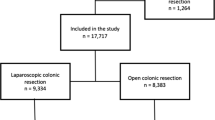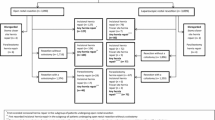Abstract
Purpose
Incisional hernia (IH) is a common complication after colectomy, with impacts on both health care utilization and quality of life. The true incidence of IH after minimally invasive colectomy is not well described. The purpose of this study was to examine IH incidence after minimally invasive right colectomies (RC) and to compare the IH rates after laparoscopic (L-RC) and robotic (R-RC) colectomies.
Methods
This is a retrospective review of patients undergoing minimally invasive RC at a single institution from 2009 to 2014. Only patients undergoing RC for colonic neoplasia were included. Patients with previous colectomy or intraperitoneal chemotherapy were excluded. Three L-RC patients were included for each R-RC patient. The primary outcome was IH rate based on clinical examination or computed tomography (CT). Univariate and multivariate time-to-event analyses were used to assess predictors of IH.
Results
276 patients where included, of which 69 had undergone R-RC and 207 L-RC. Patient and tumor characteristics were similar between the groups, except for higher tumor stage in L-RC patients. Both the median time to diagnosis (9.2 months) and the overall IH rate were similar between the groups (17.4 % for R-RC and 22.2 % for L-RC), as were all other postoperative complications. In multivariable analyses, the only significant predictor of IH was former or current tobacco use (hazard raio 3.0, p = 0.03).
Conclusions
This study suggests that the incidence of IH is high after minimally invasive colectomy and that this rate is equivalent after R-RC and L-RC. Reducing the IH rate represents an important opportunity for improving quality of life and reducing health care utilization after minimally invasive colectomy.

Similar content being viewed by others
References
Jayne DG et al (2007) Randomized trial of laparoscopic-assisted resection of colorectal carcinoma: 3-year results of the UK MRC CLASICC Trial Group. J Clin Oncol 25(21):3061–3068
Dindo D, Demartines N, Clavien PA (2004) Classification of surgical complications: a new proposal with evaluation in a cohort of 6336 patients and results of a survey. Ann Surg 240(2):205–213
Green BL et al (2013) Long-term follow-up of the medical research council CLASICC trial of conventional versus laparoscopically assisted resection in colorectal cancer. Br J Surg 100(1):75–82
Schwenk W et al (2005) Short term benefits for laparoscopic colorectal resection. Cochrane Database Syst Rev 3:003145
Aquina CT et al (2015) Surgeon volume plays a significant role in outcomes and cost following open incisional hernia repair. J Gastrointest Surg 19(1):100–110
Poulose BK et al (2012) Epidemiology and cost of ventral hernia repair: making the case for hernia research. Hernia 16(2):179–183
Hellan M et al (2014) Robotic rectal cancer resection: a retrospective multicenter analysis. Ann Surg Oncol 22:2151–2158
Collinson FJ et al (2012) An international, multicentre, prospective, randomised, controlled, unblinded, parallel-group trial of robotic-assisted versus standard laparoscopic surgery for the curative treatment of rectal cancer. Int J Colorectal Dis 27(2):233–241
Samia H et al (2013) Extraction site location and incisional hernias after laparoscopic colorectal surgery: should we be avoiding the midline? Am J Surg 205(3):264–267
Charlson M et al (1994) Validation of a combined comorbidity index. J Clin Epidemiol 47(11):1245–1251
Kuhry E et al (2008) Long-term outcome of laparoscopic surgery for colorectal cancer: a cochrane systematic review of randomised controlled trials. Cancer Treat Rev 34(6):498–504
Winslow ER et al (2002) Wound complications of laparoscopic vs open colectomy. Surg Endosc 16(10):1420–1425
Braga M et al (2005) Laparoscopic vs. open colectomy in cancer patients: long-term complications, quality of life, and survival. Dis Colon Rectum 48(12):2217–2223
Navaratnam AV et al (2015) Incisional hernia rate after laparoscopic colorectal resection is reduced with standardisation of specimen extraction. Ann R Coll Surg Engl 97(1):17–21
Petrucciani N et al (2015) Robotic right colectomy: a worthwhile procedure? Results of a meta-analysis of trials comparing robotic versus laparoscopic right colectomy. J Minim Access Surg 11(1):22–28
Baucom RB et al (2014) Prospective evaluation of surgeon physical examination for detection of incisional hernias. J Am Coll Surg 218(3):363–366
Lee L et al (2012) High incidence of symptomatic incisional hernia after midline extraction in laparoscopic colon resection. Surg Endosc 26(11):3180–3185
DeSouza A et al (2011) Incisional hernia, midline versus low transverse incision: what is the ideal incision for specimen extraction and hand-assisted laparoscopy? Surg Endosc 25(4):1031–1036
Mudge M, Hughes LE (1985) Incisional hernia: a 10 year prospective study of incidence and attitudes. Br J Surg 72(1):70–71
Author information
Authors and Affiliations
Corresponding author
Ethics declarations
Conflict of interest
MW, MK, PB, GMN, JGG, LKT, PBP, MRW and JGA declare no conflict of interest.
Ethical approval
All procedures performed in studies involving human participants were in accordance with the ethical standards of the institutional and/or national research committee and with the 1964 Helsinki declaration and its later amendments or comparable ethical standards.
Informed consent
Informed consent was obtained from all individual participants included in the study.
Rights and permissions
About this article
Cite this article
Widmar, M., Keskin, M., Beltran, P. et al. Incisional hernias after laparoscopic and robotic right colectomy. Hernia 20, 723–728 (2016). https://doi.org/10.1007/s10029-016-1518-2
Received:
Accepted:
Published:
Issue Date:
DOI: https://doi.org/10.1007/s10029-016-1518-2




